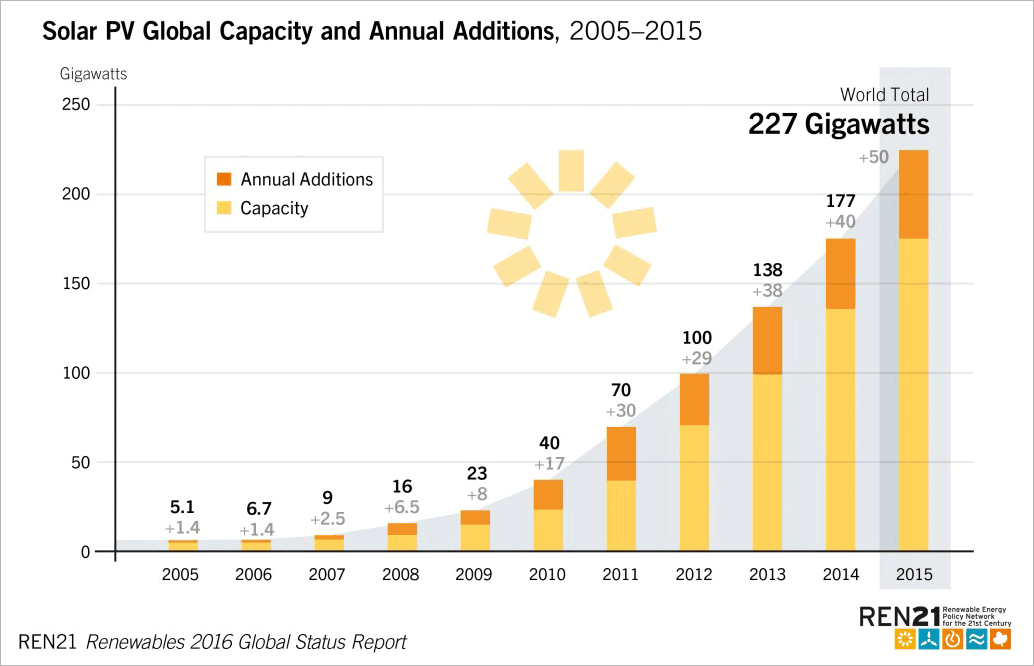Introduction
Had I realized the Renewables 2016 Global Status Report (GSR) was about to be released by the Renewable Energy Policy Network for the 21st Century (REN21), I would have held off on my previous article The Solar Story Is Just Getting Started. The reason is that the two key graphics I used in that article were updated for 2015 in the new report. In any case, I have included the updated version of the graphics in today’s story.
Each year I especially look forward to the release of two reports, which are generally released in June. The first is the GSR, which I believe is the most comprehensive report available when it comes to the global renewable energy picture. Full disclosure, I have been a contributor to and reviewer of the report for the past seven years. Each year when it is released, I like to provide an overview article, with follow-up articles delving into particular sectors.
Global Renewables Overview
2015 saw record additions of renewable energy around the world, as well as high-profile agreements and announcements related to renewable energy. An estimated 147 gigawatts (GW) of renewable power capacity was added in 2015 – the largest annual increase ever - and in spite of continued low prices for fossil fuels. The wind and solar photovoltaics (PV) had record additions for the second consecutive year. In the power sector, global capacity reached 1,849 gigawatts (GW), up 8.7% over 2014. Hydropower rose by a modest 2.7% to 1,064 GW, and other renewables collectively grew by 18% to reach 785 GW.
Read Money Is Energy: George Mobus Discusses Biophysical Economics and Alternative Theories of Value
2015 saw commitments by both the G7 (finance ministers and central bank governors of seven major economies) and the G20 (governments and central bank governors from 20 major economies) to accelerate access to renewable energy and to advance energy efficiency. But the biggest commitment of the year took place in December at the United Nations Framework Convention on Climate Change’s (UNFCCC) 21st Conference of the Parties (COP21) in Paris, where 195 countries agreed to limit global warming to below 2 degrees Celsius. A majority of countries committed to scaling up renewable energy and energy efficiency.
Solar photovoltaics (PV) continued to lead the rest of the renewable energy pack, with growth in global capacity averaging 42% annually over the past five years. Concentration solar power (CSP) continues to show strong growth as well, with an average annual growth rate of 35% over the past five years. Both, however, grew at a slower pace in 2015 than the five-year average (28% for solar PV and 9.7% for CSP).
Solar PV capacity increased by 50 GW to a record 227 GW. China added the most PV capacity with an increase of 15.2 GW over 2014. Solar PV continues to grow at a faster rate than wind power, but wind power still has nearly twice the global capacity of solar PV, with 433 GW at the end of 2015.
Renewables made up 19.2% of overall global energy consumption in 2015. This is relatively unchanged in recent years despite the rapid growth rates. Modern renewables like wind, solar, biomass and geothermal power cumulatively made up 1.4% of global energy consumption. For perspective, the number was 1.2% in 2012.
See also The Solar Story Is Just Getting Started
This illustrates one of the challenges renewables face in rapidly displacing large amounts of fossil fuel. In recent years, overall global growth in energy consumption has been greater than the additions from renewables. Hence, because renewables are such a small part of the overall energy picture, even with their rapid growth rates they struggle to keep pace with overall demand growth. As a result, they displace fossil fuels much more slowly than some have projected.
In fact, today the 2016 BP Statistical Review of World Energy was released (which is the other annual report that I especially look forward to reading). It confirms the findings of the GSR that global renewable energy consumption has never been higher, but it also shows that global fossil fuel consumption has never been higher. A decline in coal consumption last year was more than offset by increases in petroleum and natural gas consumption. The net impact was that for the 6th year in a row the world set an all-time high for carbon dioxide emissions.
In upcoming articles, I will delve deeper into the specific segments of both the GSR and the 2016 BP Statistical Review, looking at both different categories of energy production, as well as country-specific data.
Link to Original Article: 2015 Was A Record Year for Renewables








